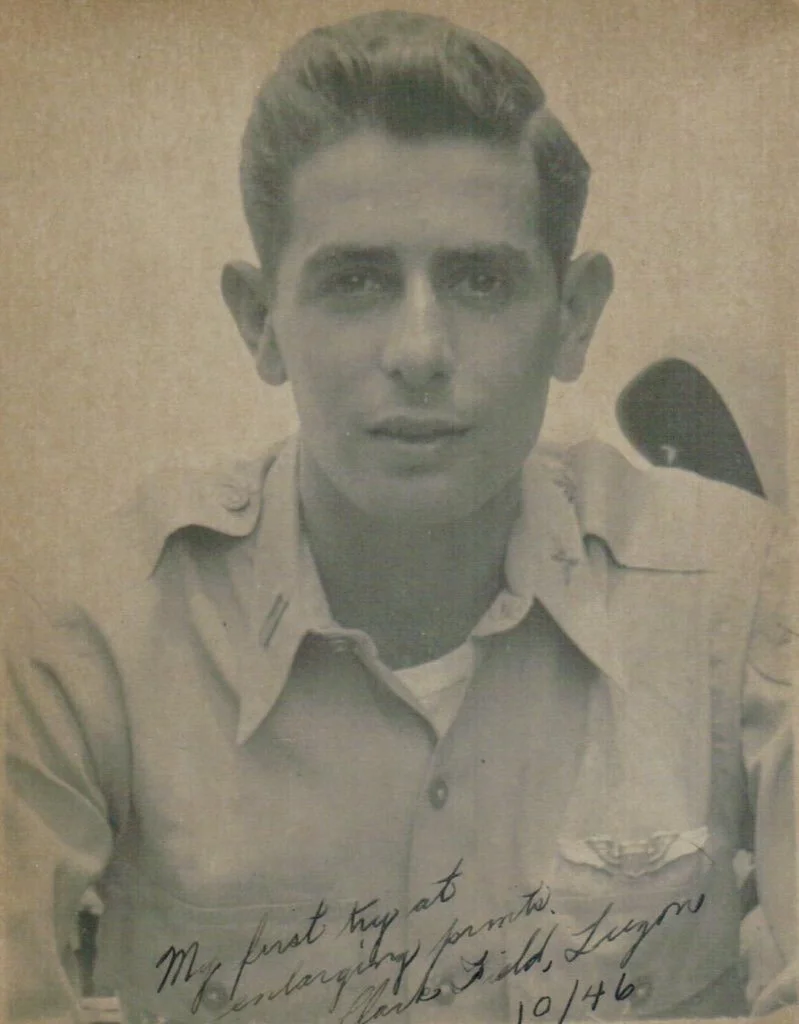“WILD BLUE YONDER”
By Shannon Robinson
THE STORY OF GEORGE BURKE - USAF - WWII
If you’re lucky enough to enjoy a conversation with George Burke, you’re in for a treat. Born in 1923 in Monaca, Pennsylvania, George grew up all boy. He played football in the street with his neighborhood friends, learned how to make homemade pasta from his mother, and fermented wine with his father; during high school, he caddied at the local golf course and managed the basketball team. However, young and full of eager potential, George always wanted to be a pilot.
Right after he graduated high school in 1941, George and his friend Franklin were admitted into the Civilian Conservation Corps, a government organization that offered opportunities for below poverty families. They traveled to a camp in Virginia where they received their uniforms, and soon the two were off to survey Shenandoah National Park. They bunked in a small log cabin (it was perfect training for the military, George recalls) and withstood the biting cold, dealing with snakes and moonshiners as they needed to. He made $30 a day and sent $25 back to his parents.
George as an Aviation Cadet on a Stearman Trainer in 1942
December 7th, 1941. George remembers listening to the radio and learning about the attack on Pearl Harbor. Soon, he was discharged from the CCC and went down to Eglin Air Force Base as a surveyor with an engineering company. He fondly remembers watching pilots fly out over the Gulf of Mexico for target practice.
In the past, you had to have a college degree to be a pilot. Then, the requirement was lowered to two years of college. In the Fall of 1942, the requirements had been changed again to passing a series of exams. At that time, George was sent to work in Florence, South Carolina, where he noticed an ad in the newspaper offering the exam application for aviation cadet training. He applied, was approved, and reported to Fort Jackson. George and over 100 other hopeful candidates tested eight hours a day for three days. After three more days of anticipation, the reported back for results. George and only two others had passed the exams. In December of 1942, he was an aviation cadet.
George was immediately called to active duty, and for the next several months he traveled to Miami Beach, Florida, Toledo, Ohio, Nashville, Tennessee, and Maxwell Field, Alabama. Every new place they went, they trained drills and physical exercises. He was selected for pilot training, and soon George was sent to an Airforce Field near Florence, South Carolina. As he describes it, it was a large dirt field with “the appearance of World War I.”
A biplane with two open cockpits was the first plane George learned to fly. He learned several aerobatic maneuvers loops, chandelles, spin recovers, and eventually “lazy eights.” Next, the cadets moved on to basic flying in a single engine, low wing, closed cockpit airplane treacherously nicknamed the “cadet killer.” Day one, a cadet was killed. Day two, an instructor and cadet were killed. Fortunately, George was not one of the casualties, and he refined his training on the AT-6 over the next two months.
After training, the unit received their overseas equipment and shipped off to Guam. George remembers looking up at the Golden Gate Bridge as they passed underneath it. He knew he wouldn’t see that sight again for a while.
There was a squadron of recon B-29s located 90 miles North of Manila at Clark Air Force Base. George volunteered to fly for one year and take photos of everything in the Pacific. He had a ulterior motive, though; there were also AT-6s he could fly between missions. George completed several solo flights over Manila Harbor and Corregidor Island. He ran mail to Manila and even received his commercial pilot’s license when FAA instructors came to base and offered pilot’s exams.
George was discharged into the inactive reserves in the spring of 1947. He soon enrolled in an Industrial Engineering program at the University of Pittsburgh. In 1949, a year before graduation, George met Gloria. He would drive her to singing gigs, and the couple would spend long nights talking in the bar together afterwards. Both Catholics, children of Italian immigrants, and native Pennsylvanians, the pair started going steady.
After graduation in 1950, George was called back into active duty. The new B-36 Bombers were coming off the assembly line, and there weren’t enough crew members to fly them. “Six prop engines, four jet engines, and capable of carrying a nuclear bomb.” It could fly at 50,000 feet, much higher than the Russian planes. Also known as the “Peacemaker,” these planes were built for the Cold War. With two years of training and preparing for a potential Russian attack ahead of him, George and Gloria made some phone calls, coordinated with a Catholic chaplain, and were married at the chapel on base. Their marriage lasted sixty-six years.
At Carswell Air Force Base in Ft. Worth, Texas, George’s training as an Aircraft Performance Engineer came in handy as the B-36 wasn’t the most reliable plane to fly on yet. Engines often caught fire and there were several crashes, so George was kept busy correcting inflight maintenance problems. Only 383 B-36s were built; they went out of service in 1959, and none of them are flyable.
Alongside B-36 training, George underwent extreme survival training to prepare for the possibility of being captured in the desolate Russian environment. He remembers being dropped off at Pike’s Peak in February. Their goal was to traverse 50 miles through the Rocky Mountains, “cross the border,” and avoid being captured by the “Soviets.” George broke ice for water, turned his parachute into a tent, and lived off of pemmican bars. Fortunately, he managed to survive and cross the border undetected. However, those who were captured were “placed in an enemy stockade to undergo interrogations and tough physical exercises.” He never had to be interrogated, but he observed those who did and was glad he missed out on the experience. Tired and trained, he returned home after a month. “Gloria’s first words were ‘Get rid of the mustache and beard’.”
The 50s were a busy time for George. After his two years of recall service were up in 1953, he worked as an industrial engineer for Chance Vought Aircraft Company. He received his Master of Science Degree in Industrial Engineering from Southern Methodist University, and he and Gloria had four children.
He continued working as an Industrial Engineer until he retired. He negotiated major military contracts with the Pentagon, negotiated contracts for the Boeing 747, and even attended a seminar about the government with a lecture from Vice President Ford.
George retired in 1983, and currently lives in Carrollton, TX, near his daughter Elaine. A man of deep faith and loyalty, George embodies the enduring spirit that America is built on.





